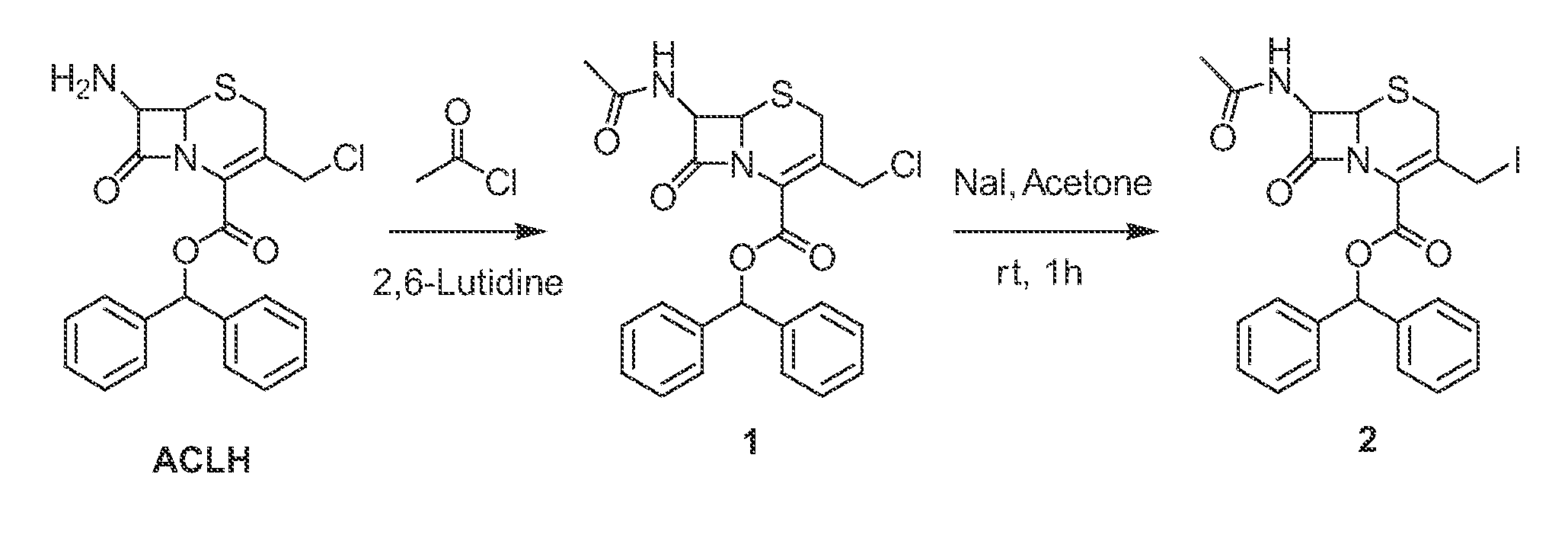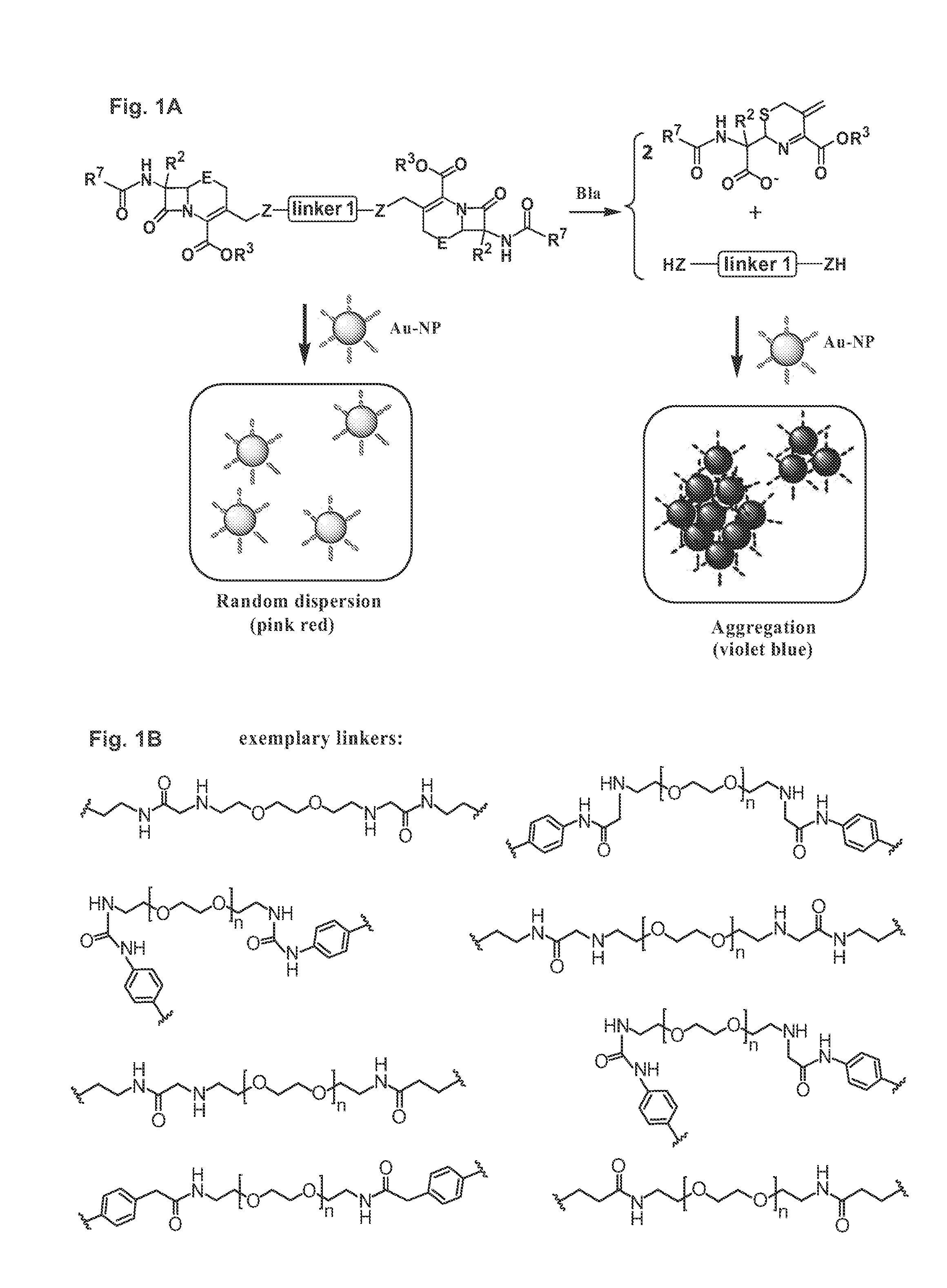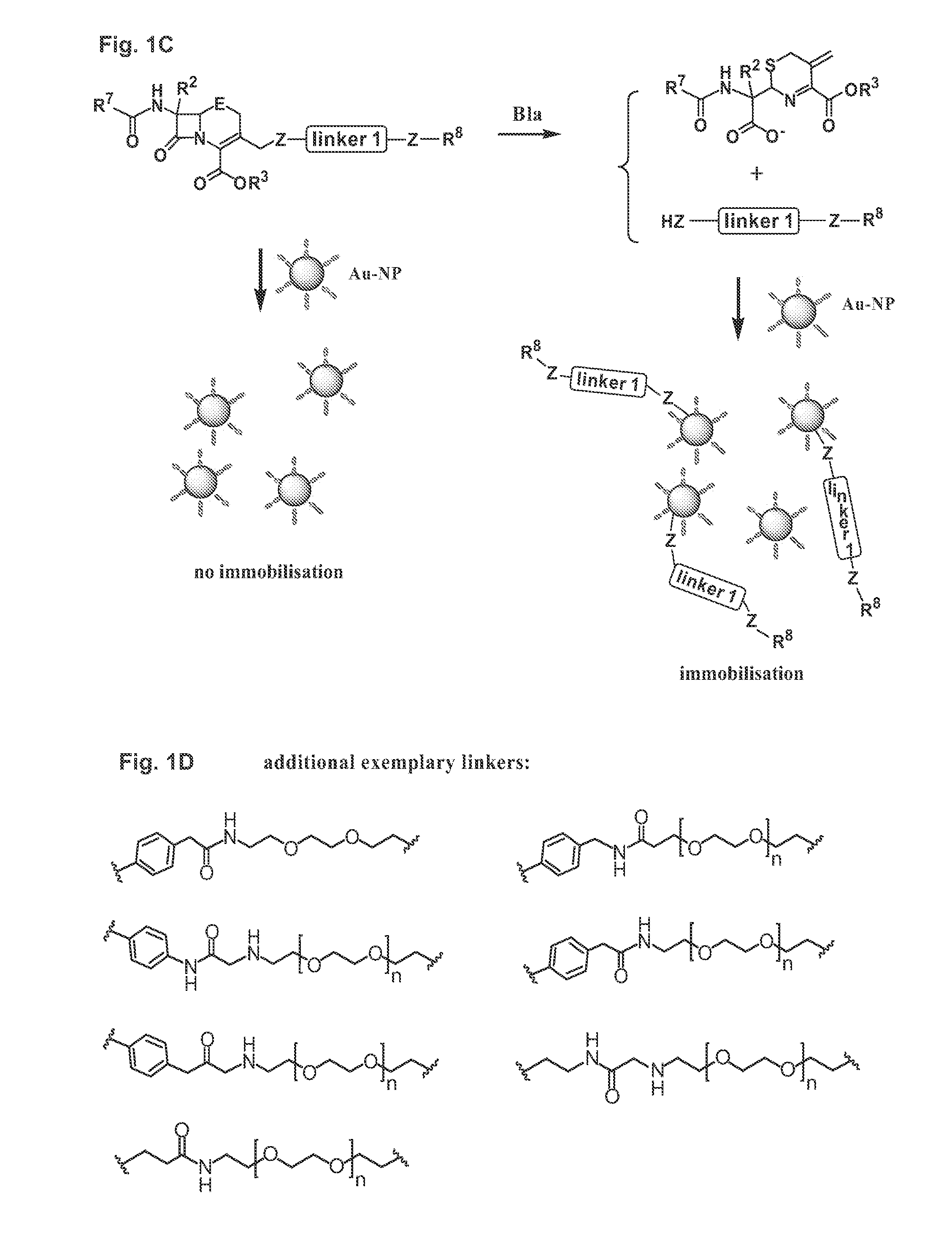Methods and compounds for detecting beta-lactamase activity
a technology of beta-lactamase and activity, applied in the field of methods and compounds for detecting beta-lactamase activity, can solve the problems of increasing the resistance of bacterial infections, threatening the ability to treat bacterial infections, and becoming a generalized concept, and achieves the effect of convenient operation
- Summary
- Abstract
- Description
- Claims
- Application Information
AI Technical Summary
Benefits of technology
Problems solved by technology
Method used
Image
Examples
example 1
Synthesis and Characterization of Enzyme Substrate 1
[0184]The synthesis of enzyme substrate 1 is shown in FIG. 2A and FIG. 2B.
[0185]Preparation of 7-(acetylamino)-3-(chloromethyl)-8-oxo-5-thia-1-azabicyclo[4.2.0]oct-2-ene-2-carboxylic acid diphenylmethyl ester (1, CAS-No 1003884-87-4): 7-Amino-3-chloromethyl cephalosporanic acid benzylhydryl ester hydrochloride (ACLH) (451 mg, 1 mmol) was suspended in dichloromethane. Then acetyl chloride (78.5 mg, 1 mmol) was added drop wise into the suspension. Finally 2,6-lutidine (214 mg, 2 mmol) was added into the reaction mixture and the solution was stirred for 2 hrs under nitrogen. After the removal of the solvent on the rotary evaporator, the residue was purified by flash chromatography on silica gel (eluent: ethyl acetate / hexane=1 / 1) to afford 223.5 mg (yield: 85.4%) of title compound. 1H NMR (400 MHz, CDCl3) 7.47-7.45 (m, 2H), 7.41-7.31 (m, 7H), 7.28-7.26 (m, 1H), 6.98 (s, 1H), 5.90 (dd, J=8.9 and 4.92 Hz, 1H), 5.01 (d, J=4.95 Hz, 1H), 4....
example 2
Synthesis and Characterization of Enzyme Substrate 2
[0192]The synthesis of enzyme substrate 2 is shown in FIG. 2C.
[0193]Preparation of p-(tritylthio)-aniline (7, CAS-No 22948-03-4): To a solution of chlorotriphenylmethane (557.6 mg, 2 mmol) in 1.5 mL of anhydrous dichloromethane was added 4-aminoithiolphenol (275.4 mg, 2.2 mmol). Then trifluoroacetic acid (TFA, 0.35 mL) was added to afford dark brown solution. The solution was stirred for 2 hrs at ambient temperature under nitrogen. After the removal of the solvent on the rotary evaporator, the residue was quenched by 1N NaOH (3 mL). The suspension was extracted with 10 mL of ethyl acetate, and the organic phase was washed with brine (5 mL×3) and dried over anhydrous magnesium sulfate. The solvent was removed and residue was purified by flash chromatography on silica gel (eluent: ethyl acetate / hexane=⅓) to afford 625 mg of desired product (85%). 1H NMR (400 MHz, CDCl3) δ 7.43 (d, J=7.24 Hz, 6 H), 7.28-7.19 (m, 9 H), 6.78 (d, J=8.4 H...
example 3
Synthesis and Characterization of Enzyme Substrate 3
[0198]The synthesis of enzyme substrate 3 is shown in FIG. 3.
[0199]Preparation of 4-[(triphenylmethyl)thio]-benzeneacetic acid (13, CAS-No 883566-52-7): 4-mercaptophenylacetic acid (369.6 mg, 2.2 mmol) was added to the solution of chlorotriphenylmethane (557.6 mg, 2 mmol) in 2.0 mL of anhydrous dichloromethane. The solution was stirred for 2 hrs under nitrogen. The reaction was quenched by 1N NaOH (3 mL). The suspension was extracted with 10 mL of ethyl acetate, and the organic phase was washed with brine (5 mL×3) and dried over anhydrous magnesium sulfate. The solvent was removed and residue was purified by flash chromatography on silica gel (eluent: ethyl acetate / hexane=⅓) to afford 713.4 mg of desired product (87%). 1H NMR (400 MHz, CDCl3) δ 7.43-7.40 (m, 6H), 7.26-7.17 (m, 9H), 6.93 (m, 4H), 3.52 (s, 2H) ESI-MS: observed [M+Na]+: 433.6, calculated: 410.5.
[0200]Preparation of N-[2-[2-(2-aminoethoxy)ethoxy]ethyl]-carbamic acid 1,...
PUM
| Property | Measurement | Unit |
|---|---|---|
| width | aaaaa | aaaaa |
| molecular weight | aaaaa | aaaaa |
| molecular weights | aaaaa | aaaaa |
Abstract
Description
Claims
Application Information
 Login to View More
Login to View More - R&D
- Intellectual Property
- Life Sciences
- Materials
- Tech Scout
- Unparalleled Data Quality
- Higher Quality Content
- 60% Fewer Hallucinations
Browse by: Latest US Patents, China's latest patents, Technical Efficacy Thesaurus, Application Domain, Technology Topic, Popular Technical Reports.
© 2025 PatSnap. All rights reserved.Legal|Privacy policy|Modern Slavery Act Transparency Statement|Sitemap|About US| Contact US: help@patsnap.com



